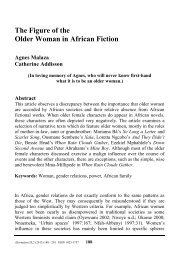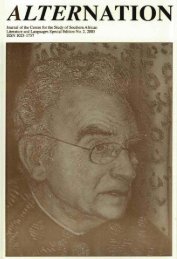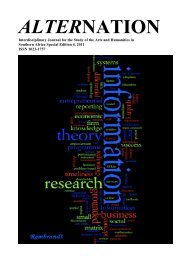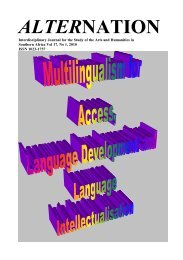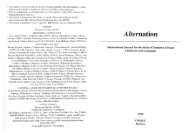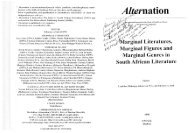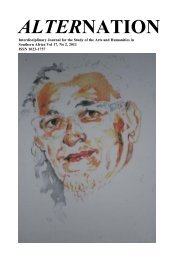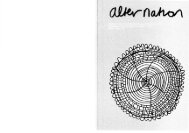Shane Moran - Alternation Journal
Shane Moran - Alternation Journal
Shane Moran - Alternation Journal
Create successful ePaper yourself
Turn your PDF publications into a flip-book with our unique Google optimized e-Paper software.
Alex la (Yurna 3 Polilics and Aesthe bzllczni Mkhize<br />
(Coetzee 197 1 :6). The writer, Coetzee correctly suggests, 'should not choose<br />
tradition at random, but rather choose it with some sense of social implications for<br />
choice' (Coetzee 197 1 :6). This is precisely what La Guma is doing, Coetzee p<br />
in his brief but illuminating examination of A Walk in the Night in which<br />
convincingly shows that this novel 'exemplifies a conception of literature radic<br />
different from Nkosi's' (Coetzee 1971 :7). According to Coetzee, La Guma's<br />
informed by a critical realist tradition which is exeinplified in La Guma's<br />
depiction of the Coloured situation and the gesture towards 'potentialities for h<br />
action' (Coetzee 1971: 11,IO) as captured in the sy~nbolisln of the 'dawn<br />
situation. Coetzee continues this line of argument in another essay, Man's F<br />
Novels of Alex la Gurna'. David Attwell (1993:12) captures Coetze<br />
argument thus:<br />
ument seems to have overlooked the fact<br />
his and other stories is indicative of<br />
ism. Moreover, one wonders at the<br />
ar story by La Guma! The same<br />
(the documentation of minute details) is used much more effectively in A<br />
e Night, which Ndebele does not make reference to because, one suspects, it<br />
question the validity ofhis argument with regard to La Guma.<br />
This debate invokes the 1930s debates between Lukacs and Brecht amongst<br />
ers which were triggered oflby Lukhcs's attack on Bloch's e~~ressionisrn". In the<br />
a1 version of the debate it would seem that Nkosi subscribes to Brecht's argument in<br />
the use of the experimental line ofmodernism is seen as coinpatible with<br />
ealistic aesthetic. For example, Nkosi (1979:223) has a lot of praise for Bloke<br />
[I] 'Man's Fate in the Novels of Alex IaGuma' Coctzce goes on to argue. via<br />
George Lukacs's studies of realism, that La Guma is a critical realist who<br />
politicizes his art by gesturing toward a revolutionary transformation of<br />
liistoly encoded in characterization and symbolism: thus, J,a Gulna arrives<br />
at liar]-ative solutions that have an implicitly progressive social<br />
Iierrueneutic.<br />
isane's Blame Me On Hislory because it 'shows a dedication to a superior form of<br />
ich succeeds partly because the author is alive to the fact that reality itself is<br />
to the process of Time as an orderly sequence of events'. Coetzee, it has been<br />
s Lukacs in his defence of La Gurna's oeuvre. Unlike Nkosi, who<br />
s towards modernism, Ndebele does not seem to be suggesting that<br />
should dispense with the realist tradition per se; instead, he postulates a<br />
a realist aesthetic in terms ofwhich individual characters in a text grapple with<br />
In a word, then, ],a Gunla is a social realist who is conscious of the ideologi<br />
implications ofworking within this tl-adition.<br />
Seventeen years after the publication of Nkosi's essay, this debate was tak<br />
up by Njabulo Ndebele. Following Nkosi, Ndebele argued in 'Turkish Tales and<br />
Thoughts on South African Fiction', a11 essay that has since become seminal in<br />
African critical debates, that 'what we have (in South African black iiction) is cr<br />
internal' contradictions of their identity. Michael Vaughan (1 990: 194),<br />
, has show11 how Ndebele's own fictional work, Fools and other .storie.r., is<br />
itten in the realist tradition but is also targeted at the development of an<br />
lectual leadership'. La Guma's project, on the contrary, was directed elsewhere.<br />
is LaGuma on this point:<br />
writing's allnost obsessive elnulation of journalism' (Ndebele 199 1 :45). Having read South African literature, I discovered that nothing satisfactory<br />
apparently heavy reliance on an obsessive docurnentation of oppression has, accordi~lg or worthwhile from my point of view had been written about the arca from<br />
to Ndebele, inevitably led to the production of an aesthetic of 'anticipated su~faces which 1 sprang. So1 think there was a conscious effort on my part to place on<br />
rather than one of processes'. an art which lacks the potential for a transfo~<br />
impact on 111e reader's consciousness because it is grounded on political<br />
SLIC~I kind of fiction thrives on an aesthetic effect based on 'identifi<br />
record the life in the poor areas. working class areas, and perhaps for that<br />
reason most of 11iy work is centred around that community and life (La<br />
Gullla 199 1 :9).<br />
'1-ecognition' (Nriebele 1gC)1 :35), Ndebele argues. Ndebele takes debate lnu<br />
furttier in his later essay, 'The Rediscovery of the Ordinary', suggesting that write<br />
sl~ould 'rediscover the ordi11at-y' by exploring a wide range of hurnan experience,<br />
thoreby avoiding 'the representation of'the spectacle' (Ndebele 199 1:37) as ernbod'<br />
in narratives which are preoccupied with a documentation of oppressi<br />
Rediscovering the ordinary, it turns out, also includcs an effective use ofsubtlety so t<br />
the reader's imaginative faculty is challenged and, in this way, the transformation o<br />
hisll~erco~~sciousness is assured.<br />
Curiously. Ndehele provides [,a Chrna's story 'Coffee for the Road' as an<br />
Gulna here clearly identifies himself with, and regards his poi111 of view as<br />
nsistent with, that of the working class: in aword, his ambition was to create a South<br />
can working class (proletarian) literature-at least in terms of content (the question<br />
hetherhe also had the working class as his virtual readership is another matter). It is<br />
us no surprise that in line with his attempt to 'put on record' the lives of the poor<br />
working classes, La Gurna perceives his role as a writer and his 'finction as that of an<br />
historian ofthe people' (La Guma 199 1 :2 1). It should be clear, then, that the ideological<br />
exalnple of the 'spectacular' and cites amongst orher things, 'the co-rnplete extcriori<br />
ofeveiything', 'tho dramatic contl-asts all over the story' and the 'intensifying device " For this debate see Aesthetics and Po1itic.s (1971). A surn~~iary of these debates is also<br />
hyphenated adjectives' as pointers to the 'spectacle' in this story (Ndebele 199 1 :4<br />
There are no grounds to doubt the persuasiveness of Ndcbele's argu~nent in this rega<br />
provided in Johnson's Mclusist Aesthetics (1984). I,unn's Marsi.sn~ cind Morlerni.sriz (1 982),<br />
Bisztray's Mcle~lst A4odeEel.r ofLltercz13i (1978) anci Raliianujaln's Qi~esl fur Reconc~liaiioul ( 1993).



